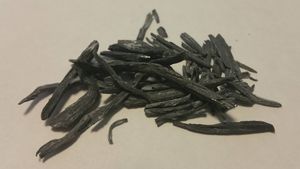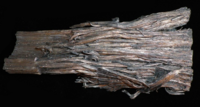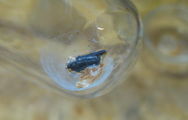Samarium
 Samarium metal | |||||
| General properties | |||||
|---|---|---|---|---|---|
| Name, symbol | Samarium, Sm | ||||
| Appearance | Silvery gray | ||||
| Samarium in the periodic table | |||||
| |||||
| Atomic number | 62 | ||||
| Standard atomic weight (Ar) | 150.36(2) | ||||
| Group, block | n/a; f-block | ||||
| Period | period 6 | ||||
| Electron configuration | [Xe] 4f6 6s2 | ||||
per shell | 2, 8, 18, 24, 8, 2 | ||||
| Physical properties | |||||
| Silvery-gray | |||||
| Phase | Solid | ||||
| Melting point | 1345 K (1072 °C, 1962 °F) | ||||
| Boiling point | 2173 K (1900 °C, 3452 °F) | ||||
| Density near r.t. | 7.52 g/cm3 | ||||
| when liquid, at | 7.16 g/cm3 | ||||
| Heat of fusion | 8.62 kJ/mol | ||||
| Heat of | 192 kJ/mol | ||||
| Molar heat capacity | 29.54 J/(mol·K) | ||||
| pressure | |||||
| Atomic properties | |||||
| Oxidation states | 4, 3, 2, 1 (a mildly basic oxide) | ||||
| Electronegativity | Pauling scale: 1.17 | ||||
| energies |
1st: 544.5 kJ/mol 2nd: 1070 kJ/mol 3rd: 2260 kJ/mol | ||||
| Atomic radius | empirical: 180 pm | ||||
| Covalent radius | 198±8 pm | ||||
| Miscellanea | |||||
| Crystal structure | Rhombohedral | ||||
| Speed of sound thin rod | 2130 m/s (at 20 °C) | ||||
| Thermal expansion | 12.7 µm/(m·K) (α, poly) | ||||
| Thermal conductivity | 13.3 W/(m·K) | ||||
| Electrical resistivity | 9.4·10-7 Ω·m (α, poly) | ||||
| Magnetic ordering | Paramagnetic | ||||
| Young's modulus | 49.7 GPa (α form) | ||||
| Shear modulus | 19.5 GPa (α form) | ||||
| Bulk modulus | 37.8 GPa (α form) | ||||
| Poisson ratio | 0.274 (α form) | ||||
| Vickers hardness | 410–440 MPa | ||||
| Brinell hardness | 440–600 MPa | ||||
| CAS Registry Number | 7440-19-9 | ||||
| History | |||||
| Naming | After the mineral samarskite (itself named after Vassili Samarsky-Bykhovets) | ||||
| Discovery and first isolation | Lecoq de Boisbaudran (1879) | ||||
Samarium is a lanthanide with the symbol Sm and atomic number 62. It is a grayish-silvery metal, with similar reactivity to magnesium. Its chemical behavior is similar to most other rare earth metals, but it is notable for the presence of a blood-red samarium (II) ion in reducing conditions.
Contents
Properties
Physical properties
Samarium is a grayish metal that is about as dense as iron or manganese. Freshly cut pieces are very shiny and lustrous, while older ones are generally darker from a thin oxide layer. It is very slightly paramagnetic - more so than vanadium, but less than europium, and can be very easily demonstrated by placing a piece on a styrofoam block on water and pulling it with a neodymium magnet.
Chemical properties
As a lanthanide, samarium is quite reactive, but its corrosion resistance is between that of the light and heavy rare earth metals. Exposure to air will eventually turn it to a white powdery oxide, but it is nowhere near as reactive as europium or lanthanum. It burns in air to from yellowish samarium(III) oxide in a bright red flame. It reacts only sluggishly with some reagents, like iodine to form samarium(III) iodide.
Samarium is notable for the existence of a dipositive ion, samarium(II), which is a strong reducing agent, as the tripositive ion is more stable. Its most common form, samarium(II) iodide, will reduce water and acids to hydrogen, and is an effective one-electron reductor for organic synthesis (the Barbier reaction is its most notable use, and it's well known for catalyzing the pinacol coupling reaction). Its dramatic color change from nearly black to pale yellow in THF makes it an excellent redox indicator as well. The dipositive ion, which forms a blood-red to mauve coloration, has occasionally been observed when samarium metal is placed in hydrochloric acid, though it appears to be quickly oxidized upon production. A standard laboratory prep for the compound is addition of the metal to a solution of 1,2-diiodoethane in tetrahydrofuran.
Availability and preparation
Samarium is more common than iodine on Earth, but it is hard to find and expensive. It is, however, one of the cheapest lanthanides, along with gadolinium. One source for samarium, as well as other rare earth metals, is Metallium. It is sold in 5 and 40 gram sizes, as well as rods, ampoules, and coins. Samarium metal is sold in even larger amounts on eBay, but Metallium also takes custom orders of turnings, large cast ingots, and powders. Samarium(III) oxide is relatively cheap among rare-earth compounds, and can be reduced to samarium metal with lanthanum powder in a thermite-like reaction. The most common way to extract elemental samarium, however, is the electrolysis of molten anhydrous samarium(III) chloride.
Projects
- Make Sm compounds
- Red pyrotechnic mixtures
- Reductions with samarium(II) iodide
- Dissolving samarium in liquid ammonia to produce solvated electrons
The mysteries of samarium(II)
Work has been done on the stability of the samarium(II) ion in aqueous solution, but research is incomplete. It is also unknown how to coax samarium to react with iodine, as the reaction is very sluggish.
Safety
Storage
Samarium metal tends to corrode, so sealing it in an airtight container is recommended. Mineral oil also helps with preservation of the metal. Samarium does not corrode as fast as europium, calcium, or sodium, so taking it out in air for a few minutes at a time will not affect the sample.
Toxicity
Samarium compounds have not been investigated for their toxicity, and should be treated as mildly toxic. Salts of samarium, especially the halides, tend to hydrolyze at elevated temperatures and may emit noxious or strongly acidic vapors.
Flammability
Samarium as small pieces will ignite in the presence of an open flame, and samarium dust and powder may ignite spontaneously in air. Samarium and europium fires can be identified due to their bright red flames. Class D fire extingushers should be at hand. Water may aggravate burning samarium and should never be used.

